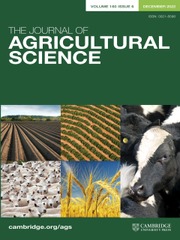Article contents
Inheritance of Seed Shape and Resistance to Ascochyta Blight in Pea (Pisum sativum L.)
Published online by Cambridge University Press: 27 March 2009
Summary
To ascertain the inheritance of seed shape and resistance to Ascochyta blight and to incorporate resistance in commercial cultivars, crosses were made between cv. Kinnauri, a round-seeded resistant source and commercially important cvs Bonneville, Lincoln, GC 141, and Selection 18, highly susceptible to disease but wrinkled-seeded. The F1, F2 and F3 data indicated that seed shape and resistance to Ascochyta blight is determined by two independently inherited genes. Round seed and disease resistance are dominant over wrinkled seed and susceptibility. Commercially desirable lines have been selected which combine the resistance gene of Kinnauri with wrinkled seed from susceptible commercial cultivars, and which also possess high pod yields and other desirable characters.
Information
- Type
- Research Article
- Information
- Copyright
- Copyright © Cambridge University Press 1984
References
- 6
- Cited by

